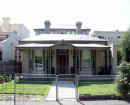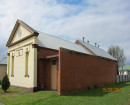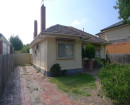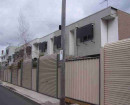TIMBOON HOUSE (FORMERLY LAKE INN)
320 OLD GEELONG ROAD SKIBO, CORANGAMITE SHIRE
-
Add to tour
You must log in to do that.
-
Share
-
Shortlist place
You must log in to do that.
- Download report






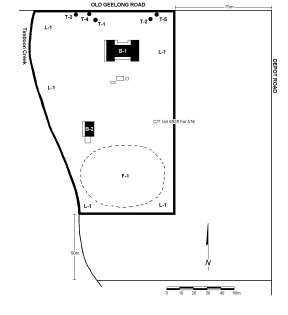




Statement of Significance
What is significant?
Timboon House (formerly Lake Inn) at Camperdown was constructed in 1855-56 for publican Samuel Cozens. It was the second inn on the site and was strategically located on the former Geelong/Belfast/Portland road where a wayside stop had been in existence since the early 1840s. Timboon House was part of the now defunct Lake Timboon settlement, the precursor to Camperdown, which originally included a general store, shoemaker's shop and post office, burial ground, a National School and residences. The archaeological remnants of the former Timboon Inn lie beside the weatherboard stables building. By the late 1850s the focus of settlement in the area had moved to present-day Camperdown and the Lake Inn ceased to be commercially viable; it was subsequently used as a private residence. The two storey, bluestone, Colonial Georgian structure has flanking single storey wings, an unusual 'H' plan layout, regular six-pane Georgian fenestration, loopy bargeboards (only one remains) and a slate roof. The wings may be slightly later additions and the original balcony verandah has been removed. The main building retains key elements of its inn function, including a series of small accommodation rooms. The timber stables building is in poor condition although its shingle roof remains under the corrugated iron. The former inn is surrounded by introduced trees including the remains of an orchard. The drive is flanked by impressive mature oak and ash trees.
How is it significant?
Timboon House (formerly Lake Inn) is historically, architecturally and archaeologically important to the State of Victoria.
Why is it significant?
Timboon House (formerly Lake Inn) is historically important as one of the most intact early inns remaining in western Victoria. Its size also emphasises the important function of the inn during the age of coach travel, when it was strategically located on the main thoroughfare through the Western District. Timboon House is important as a key remnant of the former Lake Timboon settlement, which was the site of one the earliest European settlements in the region. It is also one of the oldest buildings in the district, and the largest of the early stone buildings in Camperdown. Though Timboon House is now located in an area long bypassed by the main highway and the urban development of Camperdown, it is testament to earlier settlement and communication patterns in the region, which in turn was the focus of some of the most intensive and successful pastoral development in the State.
Timboon House (formerly Lake Inn) is architecturally significant as a rare and essentially intact example of a purpose-built 1850s Colonial Georgian style inn. Its design elements, including an unusual 'H' plan layout where single storey wings flank a two storey bluestone structure, make it a distinctive landmark structure in the oldest settled area of Camperdown. The substantially intact internal inn layout, including the existence of a series of small accommodation rooms, distinguishes it from contemporary domestic residences. The extensive plantings of exotic species, including the large mature oaks and ashes flanking the entrance drive, are important elements in the layout of the former inn.
Timboon House (formerly Lake Inn) is archaeologically significant for the existence below ground of the remnants of the 1840s Timboon Inn. This and the remains of other buildings in the vicinity are significant for their rarity as a pre-gold rush wayside settlement. The relative lack of disturbance through later development means that the site has a high potential to yield artefacts of an important era in the pastoral development of Victoria.
-
-
TIMBOON HOUSE (FORMERLY LAKE INN) - History
Associated People: Owner SAMUEL COZENS;TIMBOON HOUSE (FORMERLY LAKE INN) - Permit Exemptions
General Exemptions:General exemptions apply to all places and objects included in the Victorian Heritage Register (VHR). General exemptions have been designed to allow everyday activities, maintenance and changes to your property, which don’t harm its cultural heritage significance, to proceed without the need to obtain approvals under the Heritage Act 2017.Places of worship: In some circumstances, you can alter a place of worship to accommodate religious practices without a permit, but you must notify the Executive Director of Heritage Victoria before you start the works or activities at least 20 business days before the works or activities are to commence.Subdivision/consolidation: Permit exemptions exist for some subdivisions and consolidations. If the subdivision or consolidation is in accordance with a planning permit granted under Part 4 of the Planning and Environment Act 1987 and the application for the planning permit was referred to the Executive Director of Heritage Victoria as a determining referral authority, a permit is not required.Specific exemptions may also apply to your registered place or object. If applicable, these are listed below. Specific exemptions are tailored to the conservation and management needs of an individual registered place or object and set out works and activities that are exempt from the requirements of a permit. Specific exemptions prevail if they conflict with general exemptions. Find out more about heritage permit exemptions here.Specific Exemptions:General Conditions:
1. All exempted alterations are to be planned and carried out in a manner which prevents damage to the fabric of the registered place or object.
2. Should it become apparent during further inspection or the carrying out of alterations that original or previously hidden or inaccessible details of the place or object are revealed which relate to the significance of the place or object, then the exemption covering such alteration shall cease and the Executive Director shall be notified as soon as possible.
3. If there is a conservation policy and plan approved by the Executive Director, all works shall be in accordance with it.
4. Nothing in this declaration prevents the Executive Director from amending or rescinding all or any of the permit exemptions.
5. Nothing in this declaration exempts owners or their agents from the responsibility to seek relevant planning or building permits from the responsible authority where applicable.
Exterior
* Minor repairs and maintenance which replace like with like.
* Demolition or removal of outbuildings and sheds (apart from the stables (B-2))
* Removal of extraneous items such as air conditioners, pipe work, ducting, wiring, antennae, aerials etc, and making good.
* Installation or repair of damp-proofing by either injection method or grouted pocket method.
* Regular garden maintenance.
Interior
* Painting of previously painted walls and ceilings provided that preparation or painting does not remove evidence of the original paint or other decorative scheme.
* Removal of paint from originally unpainted or oiled joinery, doors,
architraves, skirtings and decorative strapping.
* Repair of plasterwork provided that all new work matches good adjacent work in style, detail and finish.
* Installation, removal or replacement of carpets and/or flexible floor
coverings.
* Installation, removal or replacement of curtain track, rods, blinds and other window dressings.
* Installation, removal or replacement of hooks, nails and other devices for the hanging of mirrors, paintings and other wall mounted artworks.
* Refurbishment of bathrooms, toilets and or en suites including removal, installation or replacement of sanitary fixtures and associated piping, mirrors, wall and floor coverings.
* Installation, removal or replacement of kitchen benches and fixtures including sinks, stoves, ovens, refrigerators, dishwashers etc and associated plumbing and wiring.
* Installation, removal or replacement of ducted, hydronic or concealed radiant type heating provided that the installation does not damage existing skirtings and architraves and provided that the location of the heating unit is concealed from view.
* Installation, removal or replacement of electrical wiring provided that all new wiring is fully concealed and any original light switches, pull cords, push buttons or power outlets are retained in-situ. Note: if wiring original to the place was carried in timber conduits then the conduits should remain in-situ.
* Installation, removal or replacement of bulk insulation in the roof space.
* Installation, removal or replacement of smoke detectors.
-
-
-
-
-
CAMPERDOWN TURF CLUB GRANDSTAND
 Victorian Heritage Register H2093
Victorian Heritage Register H2093 -
OLD TIMBOON BURIAL PLACE AND CHARLES SIEVWRIGHT'S GRAVE
 Victorian Heritage Inventory
Victorian Heritage Inventory -
Craigburn
 National Trust
National Trust
-
'Altona' Homestead (Formerly 'Laverton' Homestead) and Logan Reserve
 Hobsons Bay City
Hobsons Bay City
-
-






